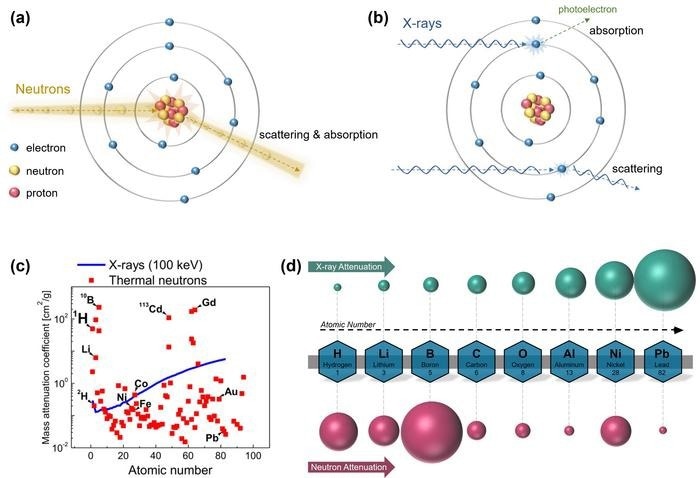Since they are acknowledged as critical energy storage devices, lithium batteries have become a necessary part of modern life. However, with the speed at which modern industry is developing, lithium batteries are finding it difficult to meet the needs of increased safety performance, longer cycle life, and improved energy density.

(A) Interaction between neutrons and nuclei. (B) Interaction between X-ray and electrons. (C) Mass attenuation coefficients for thermal neutrons and X-rays (100 keV). (D) Comparison diagram of neutron and X-ray attenuation of different elements. Image Credit: Science China Press
Advanced characterization methods must be used to investigate the internal evolution mechanisms of lithium batteries to address these urgent problems. The goal of this thorough examination is to provide a theoretical framework for the ongoing development of lithium battery technology.
Since they are electrically neutral, neutrons are able to penetrate extremely well and are highly sensitive to light elements, especially lithium and hydrogen, which are found in lithium batteries. This intrinsic property confers a unique advantage to neutron imaging in terms of observing the internal state distribution of lithium batteries.
Researchers provide a thorough overview of how neutron imaging technology is used to characterize lithium batteries in their solid, liquid, and gas phases in this article.
Within the solid phase, lithium concentration in electrodes can be analyzed via neutron imaging, which makes use of its sensitivity to the element to determine the battery’s state of charge.
In addition, it compensates for the shortcomings of X-Ray imaging in this field by providing essential insights into matters like volume variations, uneven deposition, in-situ observation of lithium dendrite formation, and other challenges linked to lithium metal anodes.
When the battery enters the liquid phase, neutron imaging can be utilized to examine how the liquid electrolyte penetrates the battery and look into problems with electrolyte consumption during battery cycling. Neutron imaging enables in-situ detection of gas generation coming from internal side reactions in the battery during the gas phase.
The study also looks into the difficulties that various battery technologies, such as lithium-metal batteries, solid-state batteries, lithium-sulfur batteries, and lithium-oxygen batteries, have encountered. It emphasizes neutron imaging’s unrealized potential in furthering the development of these developing battery solutions.
Journal Reference
Gao, L., et al. (2023) Application of neutron imaging in observing various states of matter inside lithium batteries. National Science Review. doi:10.1093/nsr/nwad238.